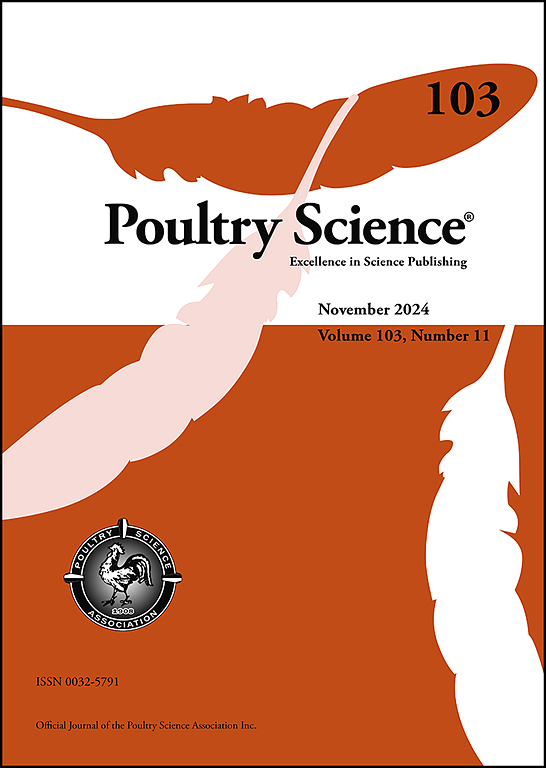Environmental contamination and horizontal transmission of Salmonella Enteritidis among experimentally infected layer pullets in indoor cage-free housing
IF 3.8
1区 农林科学
Q1 AGRICULTURE, DAIRY & ANIMAL SCIENCE
引用次数: 0
Abstract
The persistence and transmission of the egg-associated pathogen Salmonella Enteritidis in laying flocks are significantly influenced by the poultry housing environment. The present study assessed environmental contamination and horizontal transmission of S. Enteritidis within groups of layer pullets in cage-free housing after infection just before the age of sexual maturity. In each of 3 trials, 144 pullets were transferred from a rearing facility at 15 wk of age and randomly distributed between 2 isolation rooms simulating commercial cage-free barns with perches and nest boxes (72 birds/room). One wk after placement in the containment facility, a proportion of the 72 pullets in each room were orally inoculated with approximately 6 × 107 cfu of S. Enteritidis: 1/3 in trial 1, 1/6 in trial 2, and 1/12 in trial 3. At 2 wk post-inoculation in each trial, samples of liver, spleen, and intestinal tract were collected from 40 uninoculated (contact-exposed) birds in each room for bacteriologic culturing to detect horizontal transmission of S. Enteritidis. At 6 intervals between inoculation and necropsy, 5 types of environmental samples (wall dust swab, nest box swab, perch swab, flooring substrate drag swab, and flooring substrate composite) were collected and cultured for S. Enteritidis. The overall frequencies of S. Enteritidis recovery from both environmental samples and internal organs from contact-exposed pullets after initial oral inoculation of 1/3 of the birds in each room (97 % and 75 %, respectively) were significantly greater than after initial infection of 1/6 of the birds (78 % and 58 %), and S. Enteritidis recovery from birds inoculated at a 1/12 proportion (10 % of environmental samples and 18 % of organs) was significantly lower than from the 1/6 inoculation group. Flooring substrate composites were the most efficient environmental sample type for all 3 trials combined (72 % positive), providing significantly better S. Enteritidis recovery than the least efficient samples (flooring substrate drag swabs; 53 % positive). These data suggest that a high frequency of environmental contamination may be an important contributor to horizontal transmission of S. Enteritidis infections among pullets in cage-free housing.
室内散养试验感染蛋鸡肠炎沙门氏菌的环境污染及水平传播
鸡舍环境对产蛋相关病原体肠炎沙门氏菌在蛋鸡中的持续和传播有显著影响。本研究评估了环境污染和肠炎沙门氏菌在性成熟前感染的散养蛋鸡群中的水平传播。在3个试验中,每个试验从15周龄的饲养设施中转移144只小鸡,随机分配到2个模拟商业无笼谷仓的隔离室(72只/室)。在收容设施放置一周后,每个房间的72只小鸡中的一定比例口服接种约6 × 107 cfu的肠炎沙门氏菌:试验1为1/3,试验2为1/6,试验3为1/12。每次试验接种后2周,在每个房间采集未接种(接触暴露)禽类40只的肝、脾和肠道样本进行细菌学培养,检测肠炎沙门氏菌的水平传播。接种至尸体解剖间隔6次,收集5种环境样本(墙尘拭子、巢箱拭子、栖木拭子、地板基质拖曳拭子、地板基质复合拭子)培养肠炎沙门氏菌。每个房间1/3的雏鸟首次口服接种后,从环境样本和接触暴露雏鸡内脏中恢复肠炎沙门氏菌的总频率(分别为97%和75%)显著高于1/6的雏鸟首次感染后(分别为78%和58%)。1/12(环境样本的10%和器官样本的18%)接种组肠炎沙门氏菌的回收率显著低于1/6接种组。在所有3个试验中,地板基材复合材料是最有效的环境样本类型(72%阳性),提供的肠炎沙门氏菌回收率明显高于效率最低的样本(地板基材拖拭子;53%的人持肯定态度)。这些数据表明,高频率的环境污染可能是导致非笼养鸡舍中雏鸡肠炎沙门氏菌感染水平传播的重要因素。
本文章由计算机程序翻译,如有差异,请以英文原文为准。
求助全文
约1分钟内获得全文
求助全文
来源期刊

Poultry Science
农林科学-奶制品与动物科学
CiteScore
7.60
自引率
15.90%
发文量
0
审稿时长
94 days
期刊介绍:
First self-published in 1921, Poultry Science is an internationally renowned monthly journal, known as the authoritative source for a broad range of poultry information and high-caliber research. The journal plays a pivotal role in the dissemination of preeminent poultry-related knowledge across all disciplines. As of January 2020, Poultry Science will become an Open Access journal with no subscription charges, meaning authors who publish here can make their research immediately, permanently, and freely accessible worldwide while retaining copyright to their work. Papers submitted for publication after October 1, 2019 will be published as Open Access papers.
An international journal, Poultry Science publishes original papers, research notes, symposium papers, and reviews of basic science as applied to poultry. This authoritative source of poultry information is consistently ranked by ISI Impact Factor as one of the top 10 agriculture, dairy and animal science journals to deliver high-caliber research. Currently it is the highest-ranked (by Impact Factor and Eigenfactor) journal dedicated to publishing poultry research. Subject areas include breeding, genetics, education, production, management, environment, health, behavior, welfare, immunology, molecular biology, metabolism, nutrition, physiology, reproduction, processing, and products.
 求助内容:
求助内容: 应助结果提醒方式:
应助结果提醒方式:


